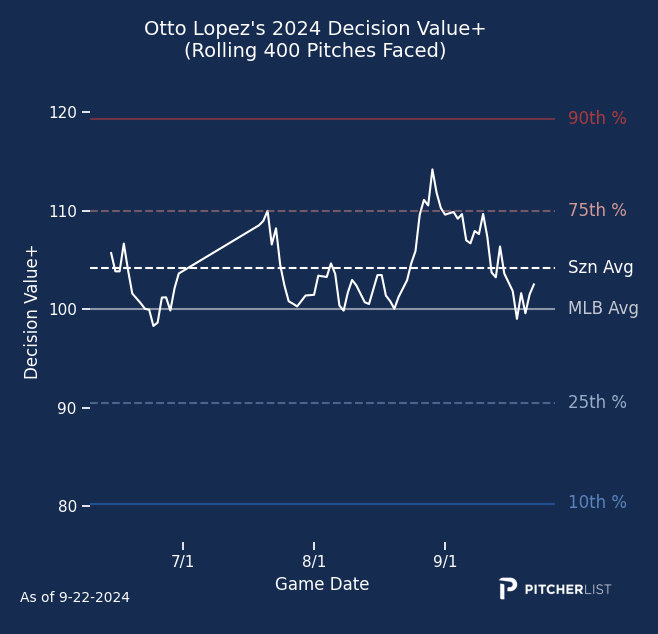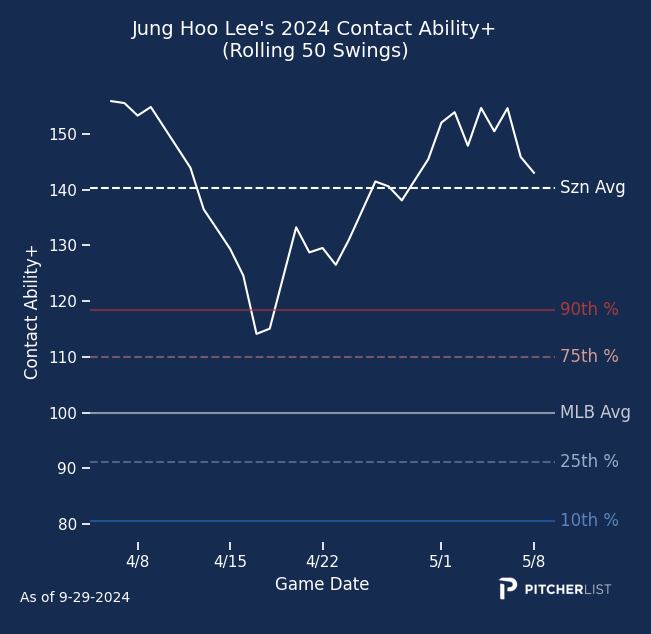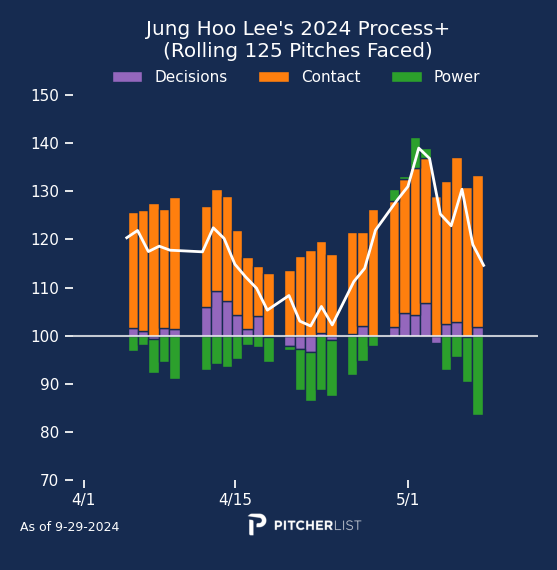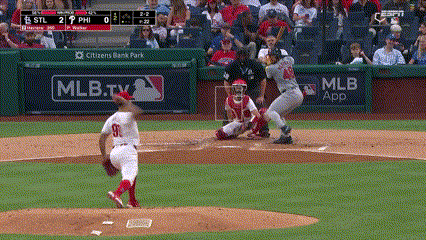Earlier this week I took a look at three pitchers that impressed in a small sample, and now I’ll turn it over to look at three hitters. Each of these players are rookies who stood out during their short time in the Show, and have a relatively low draft stock.
I’ll be honest, I hadn’t heard of Otto Lopez until researching this article. The 25-year-old Dominican rookie has bounced around the league a bit, originally in the Toronto system before being purchased by the Giants, then claimed off waivers by the Marlins to become their starting 2B. The Marlins were a disaster this year, but Lopez may just emerge as a silver lining, leading the team in fWAR—albeit with just a measly 2.3. His slash line of .268/.311/.373 isn’t very exciting, but narrowing in on the last two months of the season, Lopez hit .313/.368/.441— which are some eyebrow-raising figures, especially considering he also swiped 12 bags over that stretch.
Lopez is a glove-first, contact-heavy infielder, which gives me flashbacks to the time I tried to call Mikael Garcia a star. Oops. However, where Garcia floundered at pitches in the heart of the zone, Lopez’s +6 Run Value in the Heart of the zone indicates that he is capable of dealing with big-league pitching, and has a solid plate approach to boot.

Hardly showstopping, but Lopez makes generally good decisions, which is encouraging for a hitter who relies on their contact more than anything else. His chase rate is rather high—at 32% over the year—and his walk rate, at just 5.8%, is unappealing. However, if we narrow in on those last two months of the season, Lopez ticked his chase rate down to 30% and his walk rate up to 8% – which are much more palatable numbers if he can sustain them into next season.
He has minimal power and a very high ground ball rate—which doesn’t inspire much confidence—however, when he’s able to generate line drives his aggressive plate approach has been successful for him. While Lopez almost never hits fly balls (just a 24% FB rate on the year), but he had a 26.8% LD rate the last two months of the season—tenth in MLB over that stretch. Lopez has good speed and raw contact ability, so his ceiling will be defined if he can improve his year-long walk rate and quality of contact. If so, Lopez could potentially slot into the leadoff role for the Marlins, making him a much more appealing fantasy candidate.
The key thing for Lopez is his position (2B) which—besides Altuve and Marte—has been pretty dismal for years now. That gives Lopez a more appealing upside when considering steals and ratios. In standard 5×5 leagues, Lopez could realistically offer a .280 season with 25+ steals, which makes him far more appealing than if he played, say, SS. In deeper traditional 5×5 leagues, Lopez could provide a lot of value relative to his ADP.
Or he could be terrible. I don’t know. Predicting the future is hard. But I like Lopez’s chances.
Ok, so maybe this doesn’t really fit the “sleeper” tag, but this is my article and I want to write about Jung Hoo Lee, dangit!
In my defense, Lee absolutely fits the criteria of having a small MLB sample. After all, he only had 158 plate appearances before a shoulder injury ended his season. Lee is an interesting player to project looking forward. He is just 26 years old, with an excellent KBO career that yielded a 9-figure contract last offseason. However, in his MLB debut, Lee failed to be very productive, hitting .262 but slugging just .331. Furthermore, Lee is now coming off of two seasons that have been cut short due to injury – first a broken ankle in 2023 and now a torn labrum.
Lee is a lefty who plays in San Francisco, which is not a good combination for someone who lacks raw power. Thus, his outlook will be dependent almost solely on his contact ability—which is thankfully something Lee has in spades:

As much as we love power and plate discipline, excelling in contact ability this much gives Lee a hitter profile that’s lopsided, but still very strong—as process+ indicates:

Of course, the small sample here makes stats like process+ yield results that should be taken with a grain of salt. Still, Lee consistently graded out very strongly, largely as a result of treading water with his power and swing decisions while excelling in contact.
Lee’s plate approach shows promise as well. His IPA% is in the 97th percentile, and it shouldn’t be a surprise that Lee is a very tough out. His whiff% is just 9.9%, and he rarely gets into two-strike counts in the first place—99th percentile on pitches in 2-strike counts.
xwOBA agrees. His .327 xwOBA is significantly higher than his .284 wOBA. There’s a lot to like in Lee’s projection looking forward, far exceeding what you may expect from a hitter with an 83 wRC+.
Lee will likely hit leadoff again for the Giants next year, although I would be apprehensive to expect Lee to be a steals threat. Regardless, Lee showed in his small MLB sample that he can be a quality big-league hitter, despite this not being reflected on the surface level stats. I am willing to bet that Lee will be taken very late in redraft leagues, regardless of format, because of his injury and supposed poor performance last season. However, Lee has plenty of potential to be a quality sleeper for AVG leagues.
Catchers had a weird year in 2024. Adley Rutschmann was dismal after getting injured, Salvador Perez had a huge bounceback year, Austin Wells came out of nowhere to be one of the very best in the league, and the Contreras brothers firmly established their dominance. Yet it was Willson Contreras’ partner that may have impressed the most.
Iván Herrera was stupendous. In 72 games with the Cardinals, the 24-year-old hit .301/.372/.428 for a 127 WRC+, one of the most productive offensive seasons of any rookie this year. It’s a fitting slash line for someone with such a Mauer-esque swing:


Mauer’s swing is flipped here, hence why it appears like he’s taking off toward third base (bonus points if you can guess the pitcher here). Still, these two swings look very similar. So do their stats:
